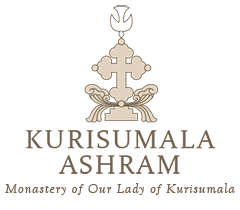Spiritual Objectives
Monastic life is something common to the great religious traditions of the world. In India, it originated centuries before Christianity, prompting the noted theologian Raymundo Panikkar to term it the ‘primordial religious dimension’. And yet, it is well and truly a mystery, a spiritual reality that eludes clear explanation. What follows is just an overview of what monastic life is all about, and, more specifically, how it finds expression at Kurisumala Ashram.
What is the monastic charism? Simply put, it is to seek God with an undivided heart. This calls for a radical renunciation of everything that clamours for the heart’s attention and tends to divide it. A Christian monk renounces home, possessions, marriage, the ‘world’ and ultimately himself in order that he may possess Christ and, in turn, be possessed by Him and eventually be transfigured into His likeness. Though separated from the world by his renunciation, he nevertheless remains united with all in Christ, as Evagrius, one of the Church fathers, has so rightly said. “In order to be truly ourselves, we must find ourselves in Christ—which can only be done if we lose ourselves in Him. This is our great vocation” says Thomas Merton, the famous Cistercian author, of a monk’s self-emptying, or kenosis, effected through his renunciation.
This ancient tradition manifests itself at Kurisumala in three distinct strands: the three charisms of Kurisumala, as Francis Acharya like to call them:
Syrian Liturgy: An oriental and essentially poetic liturgy deeply rooted in the thought and language of the Bible, with a vivid sense of the resurrection.
Indian Monastic Lifestyle: Inculturated, simple, nature-oriented and austere.
Benedictine-Cistercian Spirituality: Based on the Cistercian interpretation of the Rule of St. Benedict, with its emphasis on community prayer, manual labor and Lectio Divina (meditative, prayerful, spiritual reading).
Syrian liturgy is replete with poems by the likes of St. Ephrem—aptly named “Harp of the Holy Spirit”—and Jacob of Serugh. These poems are notable for their symbolic excellence, richness of imagery and ability to elevate the believer’s hearts. These devotional poems and the predilection of the Syrian tradition for austerities and closeness to nature make it ideal for an Indian setting. The Syro-Malankara Qurbana celebrated on Sundays and feastdays, the Bharatiya Pooja on weekdays, the hymns sung at the regular prayer services, the bhajans and keertans sung at the Satsang, the icons on the southern wall of the church, the brass lamps in front of the tabernacle and elsewhere, the saffron robes and bare feet of the sannyasis, the colourful copes used during Qurbana, the vegetarian diet and sparse furnishings are all concrete manifestations of this ‘marriage’ between the Syrian and Indian traditions effected at Kurisumala.
In the Benedictine-Cistercian tradition, the monastic vocation is pursued in a monastery under a Rule and an Abbot. Bound by vows of stability, fidelity to the monastic way of life (which includes poverty, chastity, simplicity and all other monastic practices) and obedience, the monks follow a life in community modeled on the early Church of Jerusalem. Drawing nourishment from the Holy Eucharist and the spiritual riches of the prayers of the Church celebrated in the liturgy of the hours, they dedicate themselves to a life that is ‘ordinary, obscure and laborious’, a life of faith, hope and love.
Day in and day out, they strive towards that ideal of unceasing prayer—prayer for the world, for the unity of the Churches, for peace…
